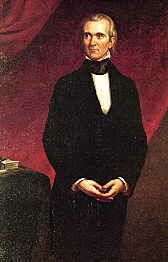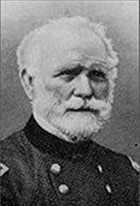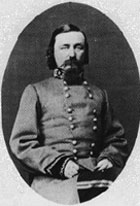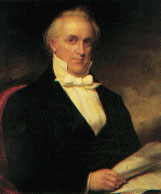The War that never happened

The American camp on San Juan Island

The American camp on San Juan Island
It is always useful and entertaining to know about the events and players that lead up to an event. With that in mind, let me begin a few years before the Pig War took place. But first, the pig war was not a war. The only casualty was the pig, who probably deserved it.
| In 1818, the Treaty to end the
War of 1812 between the United States and Great Britain, which controlled
Canada, established the boundary between Lake of the Wood west to the
Rocky Mountains at the 49th Parallel and west of the Rockies, joint
occupation of the Oregon Territory, which was at that time, the area west
of the Rocky Mountains, between the 42nd parallel north (California/Oregon
Border) and 54° 40' north (the southern boundary of Russia's Alaskan
Territory). A few years later the Russians accepted the southern most boundary of Alaska at 54°- 40' with treaties agreed to during 1824 - 1825. James Polk (1795-1849), the twelfth President of the
United States, was a stanch Democrat who, like his father, was an ardent
follower of former President Thomas Jefferson, as well as friends and
admirer of Andrew Jackson. These would be the two most influential figures
on James Polk's political career. A strong believer in expansionism, he was vocally for the annexation of Texas from Mexico, as well as his belief that the U.S. should possess all of the Oregon Territory. His campaign slogan "54-40 or fight" meant that he was willing to fight (Great Britain) for the Oregon Territory north to the 54° 40' parallel, which would have given the U.S. possession of what is now British Columbia. |

|
At that time, there was a strong belief in the west in
"manifest destiny", that it was God's will that the entire continent belonged to
the United States, and Democracy. This belief, and his stand on expansionism
made Polk a popular figure in the west and allowed Polk to take all of the
western states, except Ohio and Tennessee. However, he only won the election
because a third candidate, James G Birney, of the antislavery Liberty Party took
enough votes away from the republican Henry Clay in New York to allow Polk to
win the state and the national election.
Due to the
impending crisis with Mexico over California and Texas and under the advice of
the Senate in 1846, President Polk agreed to uphold the provisions of the 1818
treaty. The Oregon Treaty, signed on June 15th, 1846, gave the U.S. undisputed
possession of the Pacific Northwest south of the 49th parallel. The boundary
extended "to the middle of the channel which separates the continent from
Vancouver's Island, then southerly through the middle of said channel and of
Fuca's Straits to the Pacific Ocean."
As early as 1845, The Hudson's Bay Company, which occupied the area to reap the benefits of the active fur trade industry and was based out of Fort Victoria, had posted claim of possession on the Island of San Juan which is located in the area between the southeastern shore of Vancouver's Island and the northwestern shore of the continental United States just south of the 49th parallel.
Therein lies the problem; the treaty of 1846 didn't specify WHICH channel. The British believed that it was the Rosario Straight to the east, the Americans were quite certain that it was the Haro Straight to the west. San Juan Island is situated right in the middle of these two, and both countries felt that the island was theirs to settle.
Because the area north of the 49th parallel and west of the Rockies had not attracted permanent settlers, in 1849, the British government leased Vancouver's Island to the Hudson's Bay Company for 7 shillings a year (approximately 49¢ at today's exchange rate) the deal provided that the Company would take over efforts to colonize.
In 1850, the Territorial Legislature of Oregon declared that San Juan was within the territorial limits.
Former Hudson's Bay Company head James Douglas was appointed governor of that colony in 1851.
In January, 1853, the Territorial Legislature of Oregon incorporated the island into Island County. In March 1853, when the U.S. divided the Oregon Territory into the Oregon Territory and the Washington Territory along the 46th parallel and the Columbia River, San Juan was officially attached to Whatcom County, the northernmost county in the newly created Washington Territory.
By the end of 1853, Hudson's Bay Co. had established Bellevue Farm, a 4,500 head sheep ranch along with a salmon curing station, which was located on the island in 1850, on the 24-mile long by 8-mile wide island of San Juan.
The first sign that there was a problem here was in 1854 when U.S. customs collector, Isaac N. Ebey and his deputy Henry Webber landed on San Juan and attempted to collect duties from the farm manager, Charles Griffin, who himself then proceeded to fill out a warrant for the deputies arrest on grounds that he was trespassing on British soil. Nothing became of this incident.
In March of 1855, the American sheriff of Whatcom County, accompanied by ten armed men, proceeded to San Juan and rounded up 35 sheep belonging to the Hudson's Bay Company (Bellevue Farm) with the intent of selling them at auction in payment for back taxes.
The Governor of Vancouver's Island Douglas immediately protested to the Washington Territory Governor, Isaac I. Stevens and made a claim of $15,000 in damages.
When word of all this reached Washington D.C. it prompted Secretary of State William L. Marcy to write Governor Stevens requesting that the territorial officials do nothing to provoke further conflict in the area, and that neither the Americans nor the British should attempt to claim exclusive rights to the area. Marcy also sent this message to British Colonial office, which in turn passed this onto Governor Douglas.
Both London and Washington D.C. officials believed that this dispute would be settled diplomatically, and while delegations from both sides met in the area several times in 1857, nothing was settled.
By 1859, there were 18, or 22 settlers in the island, mostly
unsuccessful gold prospectors from the Fraser River valley gold fields. The
British generally still considered these Americans trespassers.
 Charles Griffin |
June 1, 1859, American settler Lyman Cutlar shot a pig
owned by farm manager, Charles Griffin of the Hudson Bay Company. "It was
eating my potatoes", Cutlar had previously warned Griffin to keep his pig
out of his potato patch, Griffin replied, "It's up to you to keep your
potatoes out of my pig". When Cutlar realized that Hudson's Bay Co. owned
the pig, he attempted to compensate for the pig, but when he was informed
that the prize breeder was worth $100 he refused to pay. Cutlar was soon
visited by A.G. Dallas, the president of the board of H.B.C. and
son-in-law to the governor, and several other men. They came to inform
Cutler, that he was trespassing and would be arrested if he did not pay
the $100 they claimed he owed. Fellow Americans requested U.S. military
protection. This they got, in the form of one Brigadier General William
Selby Harney. Harney had recently been appointed the position of Commander of the U.S. Military Department of Oregon. He was well known in the army, for his bravery in battle, but also for his foul tongue, foul temper, insubordination, and for being quite willing to bypass command to accomplish what he believed to be the goals. |
Harney visited the Americans on the island in July 1859, and helped them draft a petition requesting that he (Harney) station a military force on the island, using the ongoing threat of Indian attacks as the reason. On July 11th, Harney then proceeded to take it on his own
to order Captain George Pickett and Company D of the Ninth Infantry to set
up post on the island. Pickett would later become famous for leading the
failed attack on Gettysburg during the Civil War. Pickett arrived on July 27th, 1859, with 66 men and set up a post on a hill on the southern portion of the island, which continently overlooked Hudson's Bay's wharf. |

William Selbey Harney |

|
All this new American Military presence did not set well
with the British Governor. Douglas responded by sending Captain Geoffrey
Phipps Hornby of the British man-of-war Tribune to land a force on the
island. He was however approached by British naval officers on July 29th
to reconsider this action, which he did.
Hornby then requested that Pickett come aboard the
Tribune to discuss the matter on August 3rd. Pickett countered with a
request that the meeting be held on the island, which is where the meeting
ultimately took place. This meeting did not result in any agreement
whatsoever. |
By the end of August, Britain had assigned 5 war ships with a total of 167 guns and more than 2000 Royal marines and engineers.
It was about this time that the proverbial fecal matter was
about to hit the air circulation device for our General Harney.
| On September 3rd, the same day that the report that
Harney had sent of his original actions back in July, President James
Buchanan learned about the confrontation - through the newspapers!
Obviously, he was not pleased to learn that a very real
threat of war was brewing over a pig on this small island.
Secretary of State Lewis Cass informed Lord Lyons, the
British Ambassador that Harney was not acting under instructions by the
U.S. government. |
 |

Winfield Scott |
Scott met with Harney on October 21st and Pickett on the
22nd. He realized that both of these men thought their actions were the
correct actions under the circumstances.
General Scott met with Gov. Douglas soon after and negotiated for joint occupation of the island, as had been offered by Captain Hornby in August. He also reduced the American forces on the island
to one company, to be head by Captain Lewis C. Hunt. Douglas agreed this
to, on condition that Pickett not be reinstated to his post.
Harney refused. |
| Scott returned to the capitol, and in his report to then
Secretary of War John B. Floyd, he expressed his grave doubts about the
present situation and the wisdom of leaving Harney in command. Even after
the joint occupation agreement had been reached, the British navy didn't
commence occupation of the island until March of 1860, when clear orders
from the Admiralty had been received. At this time, they landed 84 men
under Captain George Bazalette. General Harney made one last move. On April 10th after learning that the joint occupation agreement had been made and Pickett had been replaced, he ordered Company D back to the island under command of Pickett to relieve Captain Hunt and his Fourth Infantry Division. This, in direct conflict with Scott's orders. This was the final straw. The departments of war and state agreed, and the Secretary of State Cass ordered Harney to turn over command to the next officer in rank, and report immediately the Secretaries of War and of State in Washington D.C. Surprisingly, Harney was not court-martialed. He was sent to command the Department of the West in St Louis, but after having troubles with the men there, he was recalled again in May 1861, and never held command again until his retirement in 1863. |
 Governor of the British Colony on Vancouver Island |
With Harney no longer in command, the British relaxed their objections to Pickett. Pickett left the post soon after, on June 25th, 1861 when he went to Richmond, Virginia where he was appointed colonel in the Confederate States of America.
The island remained under joint occupation for more than a decade thereafter until a German arbitrator, Kaiser Wilhelm I, ruled that the boundary was indeed located in Haro Straight. On October 21st, 1872, the island was officially American soil.
After all that, it's amazing that the only casualty WAS one dead porker, who, as I said before, probably deserved it anyway.

The Casualty
Here are some further links on the subject if you are interested in reading about the events in this little tale.
The Pig War and President Polk
National Parks Service
Site
The Old West
Site
James Polk
Biography